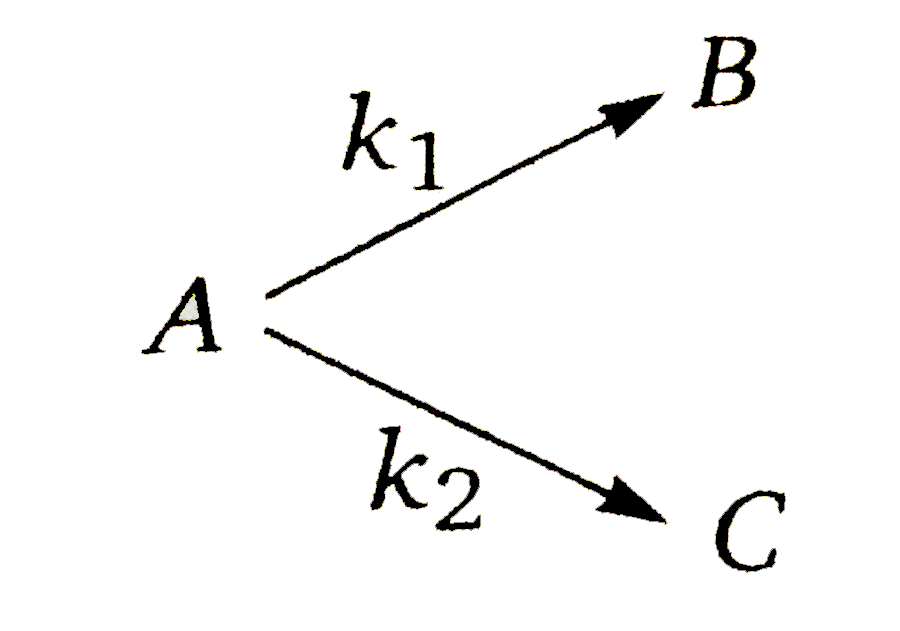A reaction takes place in various steps. The rate constatn for first, second, third and fifth steps are k1,k2,k3 and k5 respectively The overall rate constant is given by
k=k2k3(k1k5)1/2
If activation energy are 40, 60, 50, and 10 kJ/mol respectively, the overall energy of activation (kJ/mol) is :
10
20
25
none of these
The correct Answer is:C
To solve the problem, we need to find the overall energy of activation for the given reaction steps. We will use the Arrhenius equation and the provided activation energies for each step.
1. Write the Arrhenius Equation:
The Arrhenius equation is given by:
k=A⋅e−EART
where k is the rate constant, A is the pre-exponential factor, EA is the activation energy, R is the gas constant, and T is the temperature.
2. Express the Rate Constants:
For each step, we can express the rate constants as follows:
- For step 1: k1=A1⋅e−E1RT
- For step 2: k2=A2⋅e−E2RT
- For step 3: k3=A3⋅e−E3RT
- For step 5: k5=A5⋅e−E5RT
3. Substitute into Overall Rate Constant:
The overall rate constant is given by:
k=k2k3⋅(k1k5)12
Substituting the expressions for k1,k2,k3, and k5:
k=A2⋅e−E2RTA3⋅e−E3RT⋅⎛⎜⎝A1⋅e−E1RTA5⋅e−E5RT⎞⎟⎠12
4. Simplify the Expression:
This simplifies to:
k=A2⋅A121A3⋅A125⋅e−(E2R−E3R+12(E1R−E5R))1T
5. Combine Activation Energies:
The overall activation energy EA can be expressed as:
EA=E2−E3+12(E1−E5)
6. Substitute Given Activation Energies:
The activation energies are given as:
- E1=40kJ/mol
- E2=60kJ/mol
- E3=50kJ/mol
- E5=10kJ/mol
Substituting these values into the equation:
EA=60−50+12(40−10)
EA=10+12(30)=10+15=25kJ/mol
7. Final Answer:
The overall energy of activation is:
25kJ/mol
The Arrhenius equation is given by:
k=A⋅e−EART
where k is the rate constant, A is the pre-exponential factor, EA is the activation energy, R is the gas constant, and T is the temperature.
For each step, we can express the rate constants as follows:
- For step 1: k1=A1⋅e−E1RT
- For step 2: k2=A2⋅e−E2RT
- For step 3: k3=A3⋅e−E3RT
- For step 5: k5=A5⋅e−E5RT
The overall rate constant is given by:
k=k2k3⋅(k1k5)12
Substituting the expressions for k1,k2,k3, and k5:
k=A2⋅e−E2RTA3⋅e−E3RT⋅⎛⎜⎝A1⋅e−E1RTA5⋅e−E5RT⎞⎟⎠12
This simplifies to:
k=A2⋅A121A3⋅A125⋅e−(E2R−E3R+12(E1R−E5R))1T
The overall activation energy EA can be expressed as:
EA=E2−E3+12(E1−E5)
The activation energies are given as:
- E1=40kJ/mol
- E2=60kJ/mol
- E3=50kJ/mol
- E5=10kJ/mol
EA=60−50+12(40−10)
EA=10+12(30)=10+15=25kJ/mol
The overall energy of activation is:
25kJ/mol
Similar Questions
A reaction takes place in theee steps: the rate constant are k1,k2,andk3. The overall rate constant k=k1k3k2. If E1,E2, and E3 (energy of activation) are 60,30 and 10kJ, respectively, the overall energy of activation is
View SolutionA reaction takes place in theee steps: the rate constant are k1,k2,andk3. The overall rate constant k=k1k3/k2. If the energies of activation are 40,30,and20KJmol−1, the overall energy of activation is (assuming A to be constant for all)
View SolutionA reaction takes place in theee steps: the rate constant are k1,k2,andk3. The overall rate constant k=k1k3/k2. If the energies of activation are 40,30,and20KJmol−1, the overall energy of activation is (assuming A to be constant for all)
View SolutionA chemical reaction was carried out at 300 K and 280 K. The rate constants were found to be k1andk2 respectively. Then
View SolutionFor a complex reaction Ak−−→products
Ea1=180kJ/mole,Ea2=80kJ/mol,Ea3=50kJ/mol
Overall rate constant k is related to individual rate constant by the equation k=(k1k2k3)2/3. Activation energy (kJ/mol) for the overall reaction is :
View SolutionThe rate constant k1 and k2 for two different reactions are 1016e−2000/T and 1015e−1000/T, respectively. The temperature at which k1=k2 is
View SolutionKp for a reaction at 25∘C is 10 atm. The activation energy for forward and reverse reactions are 12 and 20kJmol−1 respectively. The Kc for the reaction at 40∘C will be:
View SolutionWhat is the value of rate constant k if the value of the activation energy Ea and the frequency factor A are 49 kJ / mol and 9 × 1010S−1 respectively? (T = 313 K)
View SolutionIn a reaction A+B⇔C+D the rate constant of forward reaction & backward reaction is K1 and K2 then the equilibrium constant (K) for reaction is expressed as:
View SolutionFor first order parallel reactions k1 and k2 are 4and 2−1min respectively at 300 K. If the activation energies for the formation of B and C are respectively 30,000 and 38,314 joule/ mol respectively, the temperature at which B and C will be obtained in equimolar ratio is :

View Solution
